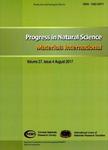Sulfur and carbon isotopic variations in Neoproterozoic sedimentary rocks from southern China
Sulfur and carbon isotopic variations in Neoproterozoic sedimentary rocks from southern China作者机构:Institute of Geology and Geophysics,Chinese Academy of Sciences,Beijing 100029,China Key Laboratory for Mineral Resources Research,Chinese Academy of Sciences,Beijing 100029,China Institute of Geology and Geophysics,Chinese Academy of Sciences,Beijing 100029,China
出 版 物:《Progress in Natural Science:Materials International》 (自然科学进展·国际材料(英文))
年 卷 期:2003年第11期
页 面:75-80页
学科分类:070902[理学-地球化学] 0709[理学-地质学] 07[理学]
主 题:Neoproterozoic southern China sulfur isotopes carbon isotopes seawater secular variations.
摘 要:A new set of δ 34S sulfide, δ 34S sulfate and δ 13C carbonate values has been reported from Neoproterozoic sedimentary rocks in southern China. The interglacial black shales of the Datangpo Fm. display higher δ 34S sulfide values with +20‰ average, but the postglacial black shales from the Doushantuo Fm. show negative δ 34S sulfide values. However, the Jinjiadong Fm., the same post-glaciation as the Doushantuo Fm., has positive δ 34S sulfide values, implying that the δ 34S value of sedimentary sulfides would be controlled by lithofacies and paleogeographic environments. The δ 34S sulfate values relative to δ 13C carbonate were obtained by extraction of trace sulfate from the successive carbonate sequences in the Yangtze Gorges sections. A preliminary interpretation suggests that the oceanic environment may fluctuate dramatically at the post-glacial Doushantuo stage and, then, recover its stability at the Dengying stage on the basis of the high resolution δ 34S and δ 13C curves of seawater.



